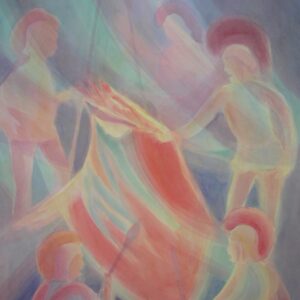Colors of the Sunrise: Light, Darkness and the Atmospheric Dance of the Soul
By Dennis Klocek 24 min read
[Republished from the Journal of Anthroposophical Medicine Vol.9 1992]
From a mechanical point of view the motion of the earth as it revolves around its axis brings into being the diverse set of phenomena known as the sunrise. From a more poetic point of view the sunrise is a rune of high significance for human life.
At sunrise, the earth breathes out her vital energies to reanimate and revivify all forms of life. This breath is a subtle stirring of the life forces. This can be experienced in mountainous country as a slight breeze which stirs the surface of a lake just as the sun strikes the peaks. Below in the valleys lies the darkness, the native power of the earth and her shadows. The play of subtle forces and tensions between the light and the shadow begins as soft stirrings, subtle movements where colors begin to flicker and gleam amid the shadowy depths.
The poet Goethe recognized that it was in this fringe zone where light and shadow meet that the true nature of color can be experienced. This zone is an interface where currents of light meet and layer over the currents of darkness. Out of this layering motion the dynamic of color arises in the world.
In nature this layering process is accomplished in many ways. A turbid atmosphere in front of the darkness of space creates the blue sky. The same turbid atmosphere in front of the light of the sun moves its color to the yellow side of the spectrum. In these phenomena, the turbid medium of air acts in polar opposite directions according to the ground tone over which it passes.
In the sunrise, the delicate play of light and dark exchanging ground and figure relationships gives rise to the complex unfolding of the color sequences. The motion of the earth slides planes of light and shadow across each other changing their relationships. As the rays of the sun first appear the preponderant motion is for light to glide across the darkness of space. This gives birth to the rising of the blues of which we will speak more in detail later in this essay. As the sunrise progresses the darkness which is covering the earth intrudes between the observer and the light behind it. This brings forward the red end of the spectrum. This separation into red and blue is at the heart of the sunrise and is the source of its mystery and healing potential. As we shall see, the gliding layers of light and shadow over each other is a product of the diurnal motion of the earth in context with the annual progression of the sun through the zodiac.
In order to begin to work with these images however, it may be of help to try to perceive the essential nature of the whole nexus of motions surrounding a sunrise. To do this more clearly we can refer to a well-known phenomenon known as the “glory.”

The “glory” is an optical phenomenon that can be experienced by any observer on a foggy day when the sun is just beginning to penetrate through the fog and irradiate the fog with light.
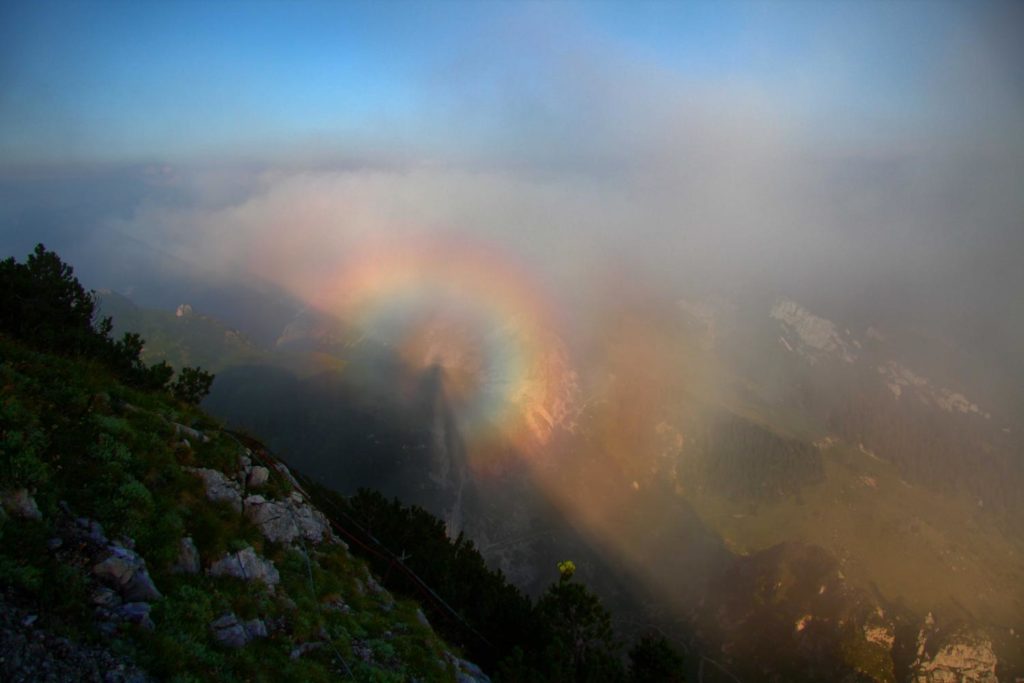
Here we have the classic situation of light meeting shadow in a turbid medium. In such a radiant fog or mist the observer should place the sun over their shoulder. This will cast the shadow of the observer’s head out into the illuminated fog in front of them. When this happens a wondrous aura of colors can be seen surrounding the shadow. Historically this phenomenon was thought to constitute the person’s aura or halo and was considered by persons in the middle ages to have mystical portent.
More recently this “glory” phenomenon can be most readily observed in the following situation. If an airplane in which one is flying crosses a field of light cirrus clouds and the sun is near the midheaven then the shadow of the plane will be cast into the fine clouds in a manner similar to the earlier example.
When this occurs the shadow of the plane will be seen as a dark shape surrounded by a field of light.The light spreads in a circle into a ring of yellow surrounded by a tinge of warm red. This constitutes the”glory” but it is not the end of this phenomenon if conditions are proper and the eye of the observer sufficiently sensitive. A further series of rings at a distance of 44 degrees from center can be seen. These rings are composed of alternating bands of bright rose-magenta-red, and parrot green. These two colors are the two special hues that arise when the polar groupings in the spectrum are blended. The color bands which compose the usual spectrum are actually two polar and separate phenomena. The red, orange, and yellow bands can actually be blended together into the hue of rose-magenta when viewed at a distance through a prism. The violet, blue, and green bands blend into parrot green, also when viewed at a distance through a prism. Rose-magenta and parrot green are the two primal colors out of which the other hues emerge. They arise where phenomena of light and dark are in a dynamic balance. In this situation where the “glory” is seen from the plane, these two colors alternate in an infinitude of pulses at the outer edge of the glory. They finally disappear into a darker outer edge where their union results in a barely perceptible violet/indigo.
In the image of the “glory” a significant mystery is revealed about the nature of color in general and the sunrise in particular. If we observe the sequence of events in a complete sunrise from total darkness through to light we can see the unfolding of the various pulses found in the different rings of its “glory.”
Sunrise
Starting about an hour and a half to two hours before the arrival of the sun on the horizon a phenomenon begins to unfold which is known as first light. At first light the most progressive roosters begin their morning call to prayer. Looking into the eastern sky we can perceive that the sky up above appears violet in contrast to a slowly greening band at the horizon. The pale green band gives a sensation of pulsation and as it grows broader it is possible to see fingers or rays of light penetrating and sliding in front of the still, violet-hued night sky. The green gives the impression of forming within itself, as it gathers force and pressure on the eastern horizon. Slowly this shifting, raying pale green force begins to lift the violet and raise it toward the midheaven.
A half hour after first light and a blue tone enters between the violet and the pale green. The green takes on the blue hue as the light begins to spread in earnest. The earth is breathing its forces out into the formation of dew at this time. The life energies which will be available to the natural world are spreading upwards from the earth. Rising mists on lakes, bird and insect movements and other related phenomena are indicators of this motion. All of this can be pictured in the blue rising into the violet just after first light. The blue begins to curve space and creates the dome of the heavens or vaulted sky we see during the day. The violet, by contrast, is flat, still, and self-contained. Its movements, if any, are subtle and flickering. The secrets of the night are contained in the violet. It is a threshold to tremendous power and energy, standing as it does as a pillar to the doorway of the visible spectrum. The still, brooding mood of the violet is overcome’ and disturbed by the rising light.
If we picture to ourselves the outer rim of the “glory” phenomenon we can see that the rising of the violet and the greening of the light are common to both the sunrise and the outer rim of the glory. The position of the violet above and the green below is consistent with the “glory” phenomena. There the outer rings of magenta and green can be seen within each other with the magenta always to the outside and the green to the inside. First light is actually the last magenta/ green band where the magenta blends into the violet of the night sky and the green is the first light of day near the horizon. The pulsing of the rising light playing into the lifting darkness is an image of the subtle fringes of repeated magenta/green bands.
When the light begins to wax strongly and the blue of the sky rises out of the green a final green/magenta crescendo is reached. Beginning at the horizon a pale rose color can be observed. This rose or magenta spreads upward and along the north and south horizon in a swelling wave. Just as the wave reaches 20 or so degrees above the horizon the whole sky above the rising sun begins to take on a pale magenta hue that overlaps the blue. When high clouds are present they glow with a cool rosy incandescence. With the blooming of this rosy hue on the clouds it is often possible to see a complete spectrum in the morning sky with reds, yellows, and oranges on the clouds and blues, greens, and violets in the sky behind. This wonderful vision only lasts for a short minute or two and then begins to quickly fade. The clouds turn grey and the sky darkens and the rosy hue disappears. As the rose bloom fades an observer who turns to look at the opposite horizon can experience a surprise. Up above the western horizon at about the same degree of elevation as from where it disappeared in the east the rose bloom hovers magically in the dark sky. It has apparently leaped over the vault of the sky and reappeared in the west.
As the sun continues to rise, this magenta rose slowly descends and gathers strength on the western horizon where it presses down on the darkness below in a striking contrast of vibrant rose above and brooding blues below. The pressing of the rose upon the blue gives rise to violets just at the horizon. This phenomenon is a manifestation of the compression and overlapping of the magenta/ green outer bands of the “glory.” It may be that we are seeing through these bands that are overlapped in space, running in advance of the rising sun. Whatever the scientific explanation, they constitute an amazing phenomenon.
At the time when these bands of color are gathering on the western horizon the eastern horizon is devoid of much color except for a faint warm red near where the sun will eventually rise. In this red there is a definite vermilion hue which replaces the rose color of the first wave.
The unfolding of the rose bloom from the horizon gives the observer the impression that the color is acting like a tincture put into a glass of water. The color first appears as a concentrated band along the horizon. As the sun rises the color spreads from its concentrated band out into the sky and is diluted by this process. The deep magenta, when spread out over the sky, turns into a bright rose. The spreading of the concentrated color into a lighter, more diluted color is at the very heart of the motion of the sunrise phenomena.
This spreading motion is most evident in the next wave of color following the rose bloom. The “glory’ model shows that the next wave of color after the rose bloom would be a deepening of the rose into a scarlet or vermilion. It can be observed in the “glory” that there is a space in which there is no color between the inner rose band and the scarlet/vermilion. If the color were to follow the order of the outer bands it would be a green. This points to the consideration that the light in nature is actually a pale green. Goethe’s prism experiments point to this as well as the fact that a thin layer of gold leaf can cast a green hue on the light when the landscape is viewed through it. Gold has since ancient times been connected to the light of the sun. The empty space in the glory where a green should be seems to confirm this ancient belief. In nature, in the sunrise this space is filled with the first appearance of true light in the morning. With this light the rose bloom fades into the west, true blues can be seen in the upper sections of the eastern sky. Dark purples and violets can be seen in the shadows on the ground and a faint yellow, orange, and green band can be seen strung between the horizon and the rising blues in the sky.
Three Color Families
In the “empty” space of the “glory” we find the emergence of the first true light accompanied by a complete continuous spectrum. This spectrum however is divided into the three great families of colors, the colors behind the light, the colors around the light, and the colors in front of the light.
The colors behind the light are the blues and violets. These colors are seen in nature in the blue of the sky and the distant mountains. They arise when light passes over a dark ground. In the sunrise they emerge with the first true light after the rose bloom. The colors behind the light are associated with space and a feeling of recession, contraction, and coolness.
The colors in front of the light represent the effect of light seen through veils of darkness. These colors are the reds, from magenta, the darkest color in front of the light through crimson, carmine, scarlet and vermilion, and orange. The reds get progressively warmer as they move closer to the light. These colors are closely associated with substances and the material world. This can be observed, for instance, in the plants which turn these colors when they die, and in the animal world as the color of the flesh and blood of the higher animals. The colors before the light are closely associated with feelings of advancing towards the viewer, expansion (inflammation), and warmth.
The colors around the light are both warm and cool. They represent the subtle veils of darkness immediately around the light. On the warm side, there is warm yellow and greenish yellow leading into the pale green of its light. These colors are veils of darkness in front of the light. On the cool side of the colors behind the light we find turquoise closest to the pale green, leading into greenish blue. The colors around the light serve as a ground to the other two tendencies. They form a bridge between the two sides of the spectrum and show up often in atmospheric situations. They are used to harmonize and support imbalances in the other spectral families.
These three families of colors appear in the morning sky as the rising sun lifts the violets high up with the outer band of the “glory.” In watercolor, fine veils of magenta and pale viridian green layered over each other create an atmospheric blue. In nature, the outer bands of green and magenta reach culmination in the rose bloom, the inner section of the outer rings.
The sunrise continues
Here the rose color continues rising with the rising sun, leaping upward from cloud to cloud and slowly spilling out along the horizon towards the west. As the rose fades from the eastern horizon a brief intermezzo is preceded by the frequent appearance of the full spectrum. The clouds show rose colors, violets and purples high up with warm reds and often oranges below. The sky ranges from violet high up through cobalt blue into turquoise near the horizon. Then comes the intermezzo, when all this color fades.
Sometimes the fading of the rose colors in the intermezzo is complete with a few minutes of neutral colors predominating in the eastern sky. Sometimes the fading is not evident at all as warm vermillions and oranges begin spreading across the lower clouds even as the higher clouds are radiant with rose/magenta. If a cloud is large enough it is sometimes possible to observe rose magenta and violet shadows at its top and vermilion and scarlet at its base. Whatever the duration of the intermezzo it is the prelude to a scherzo of flashing golden yellows, and strong oranges, vivid scarlets, and pale cool lemon yellows that accompany the actual appearance of the sun on the horizon.
With the rising of the yellows and warm reds a complete cycle of color is attained once again as the full spectrum is often evident. The inner circle of the “glory” is the earthly incarnated circle of color as opposed to the cosmic outer rings of magenta and green. The oranges, reds, and yellows are found often in the plant world and in minerals.
In the sunrise these warm substantial colors set the clouds aflame and spread in a rapid inflammatory crescendo ending with the penetrating rays of the sun’s face singing across the horizon. With this light, shadows are struck across the earth and the colors of night rush to attach themselves to objects. Where once the reds freely played in the dark atmosphere near the earth during the rose bloom they are now dried and fixed into and onto objects. The blues which during the early morning hours so freely mingle with yellows, violets, and rosy hues harden into the cobalts and crystalline sky blues of midday.
At noon all colors have fled. They hide beneath objects in little pools of shadow. Their vibrancy and motion is fixed into pale echoes by the glare of the too bright sunlight. Shadow is reduced to simply grey and black in this powerful onslaught.
Sunset
Beginning about an hour and a half before sunset however the sky in the western horizon begins to glow with a pale yellow. High clouds start to pick up a yellow version of the color which was the last strident note of the yellow flash in the sunrise. For now the “glory” will play itself out again only this time in reverse. As the sun moves towards the horizon strong oranges and vermilion reds begin to rise.
This has often been attributed to the increased incidence of particles of dust in the atmosphere due to the activity of the day. The same orange can be seen however, at daybreak just as the sun is about to rise just as it can be seen at sunset. In both instances the orange is found in the company of strong yellows and pale greens. At sunset we see oranges just before the sun touches the horizon. Similarly at sunrise, we see oranges just before the sun touches the horizon. In the morning the vermilions and scarlets spread out in advance of the yellow flash. In the evening the vermilion and scarlets smoulder on the clouds after the sun has set. In the morning the rose bloom is in advance of the sunrise by 3/4 of an hour. In the evening the rose bloom is behind the actual sunset by 3/4 of an hour.
Variation
We can see from this that the colors of sunrise and sunset are consistent and follow the same lawfulness. This is not to say, however, that there is no variation within this lawfulness. On the contrary, there are wide, yet subtle differences to be seen in the movement and duration of the different bands. It can be observed, for instance, that the “empty” intermezzo place in this glory between the rose/green bands and vermilion/yellow bands can vary considerably.
Sunrise in a tropical latitude in which the sun rises straight up from the horizon has very distinct bands of rose and a bright, cool yellow with very little orange. The rose does not pulse but spreads high and wide in the pre-dawn darkness. Then as the dawn progresses the rose lifts quickly to the western horizon where a strong rose/indigo polarity can be seen. During this time there is very little loss of color in the east as the yellow rises singing, to replace the fleeing rose on the thunderheads.
This sequence can be contrasted to a mid-winter high latitude experience in which the painfully slow rising of the winter sun takes almost two hours from first light until the sun appears above the horizon. This low angle of rise is accompanied by multiple, very pale waves of rose and green pulsing and weakening again and again on the high ice clouds. Below on the snow, violets, ethereal blues, deep indigos and cool hints of turquoise play under the pulsing roses that wax and wane for an hour before a dull, weak orange announces the approach of the sun. The last flushes of this rose usher in an extended grey period and then the pale orange begins to arise as if awakened from a deep melancholic sleep.
In a dry, mid-latitude climate pale roses pulse many times in the pre-dawn violet-hued upper atmosphere never reaching a crescendo. The climax comes slowly as the orange tones of the central color circle dominate the sunrise itself.
These observations point to the deep mystery contained in the phenomena of the “glory.” The structure of the color bands coincides with an old alchemical division into phenomena that are “moist” and phenomena that are “dry.” Moist phenomena are those which are connected to the sulfur process. Although sulfur is a combustion process there are two ways a combustion process can unfold. A moist combustion can be seen in the plant world as a plant consumes itself in order to produce flower, fruit and seed. Here fluidity fragrance and color are produced. The light from such a moist sulfur combustion tends towards the blue pole of the spectrum.
In the diagram of the glory below (Fig. 2) we see the blue pole arise where rose and green alternate.
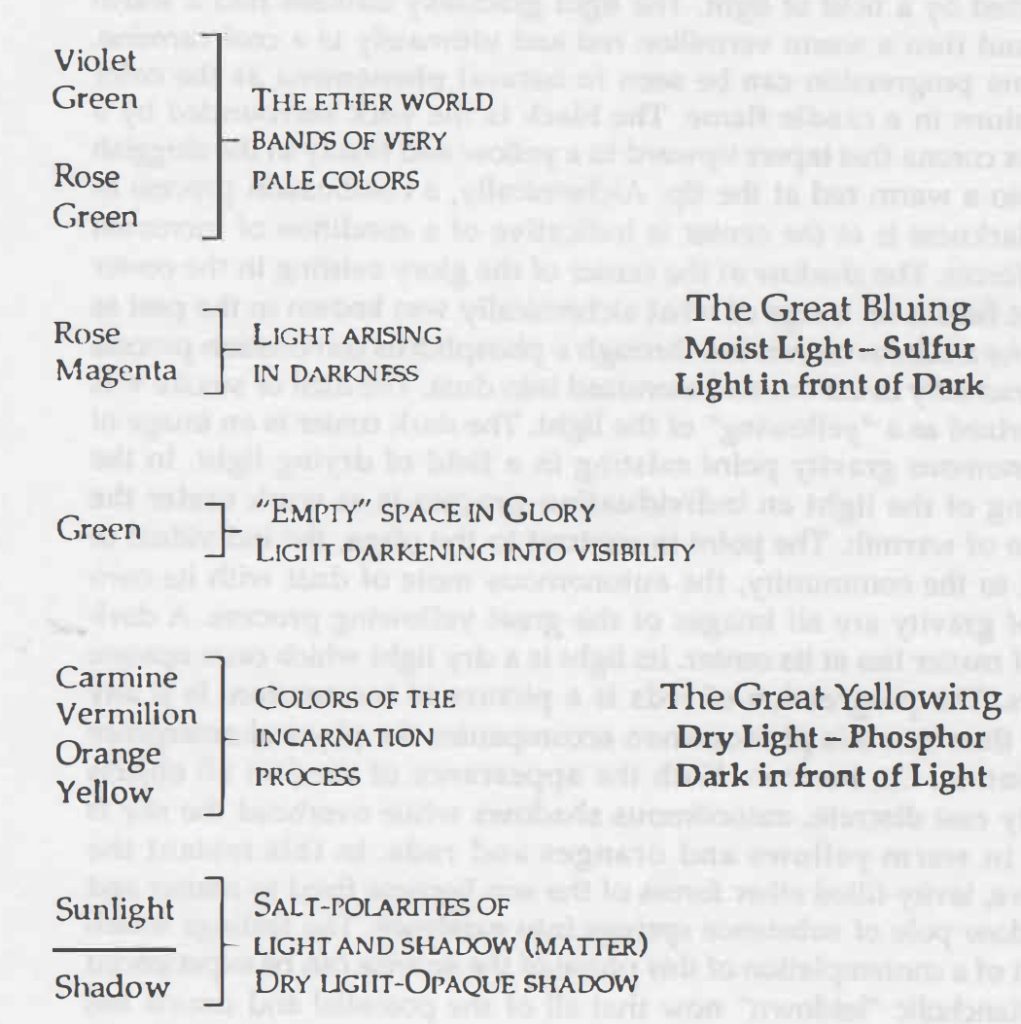
We could ask the question, how is it that blue arises out of colors which are composed of the light (green) and the darkness in front of the light (rose). To begin to answer this it is helpful if we can shift from a conception of color as it appears when attached to objects and view color inwardly as a process of becoming or arising.
From Fig. 2 we can see that there are a number of different lights and darknesses, each dependent upon its relationship to the others.

Starting in the center of the glory circle (Fig. 1) we can see the darkness labeled shadow or matter. In the glory there is always the shadow which is cast by the object into the atmosphere which serves as the focal point of the glory phenomenon. This dark focal point is surrounded by a field of light. The light gradually darkens into a warm yellow and then a warm vermilion red and ultimately to a cool carmine.
This same progression can be seen in natural phenomena as the color progressions in a candle flame. The black is the wick surrounded by a luminous corona that tapers upward to a yellow and finally in the sluggish flame into a warm red at the tip.
Alchemically, a combustion process in which darkness is at the center is indicative of a condition of increased gravity forces. The shadow at the center of the glory existing in the center of a light field is an image of what alchemically was known in the past as “dust.” As a substance was led through a phosphorus combustion process it was gradually dried out and atomized into dust. The dust or smoke was characterized as a “yellowing” of the light. The dark center is an image of an autonomous gravity point existing in a field of drying light. In the yellowing of the light an individuation process is at work under the influence of warmth. The point in contrast to the plane, the individual in contrast to the community, the autonomous mote of dust with its own center of gravity are all images of the great yellowing process. A dark vision of matter lies at its center. Its light is a dry light which casts opaque shadows.
The progression of reds is a picture of incarnation. Is it any wonder then that this phenomenon accompanies the physical emergence of the Sun on the horizon. With the appearance of the Sun all objects suddenly cast discrete, autonomous shadows while overhead the sky is bathed in warm yellows and oranges and reds. In this instant the expansive, levity-filled ether forces of the sun become fixed to matter and the shadow pole of substance springs into existence. The feelings which arise out of a contemplation of this phase of the sunrise can be experienced as a melancholic “letdown” now that all of the potential and drama has finally reached a climax in the physical light. The colors are now gone from the sky and clouds and the rich darks of the pre-dawn earth and sky begin to be diluted by the ever increasing blueness and moistness in the sky opposed to the waxing of the harsh drying light on earth. Perhaps the Druids in their reverence for the Sun shining up through the earth at midnight had an appreciation of this mood of soul and what could heal it.

If the great yellowing is an image of individuation and the dry gravity of autonomous existence its polar opposite, according to Goethe, would be a great bluing, since yellow and blue were his primary polarities. A look at the total diagram of the glory shows that nowhere is there a mention of blue. We can see that between the warm yellows which represent the darkness in front of the light and the rose/magenta and green bands there is a light gap in the color progressions. By recalling the formation of the green and rose magenta bands in Goethe’s prism experiments we can, perhaps, gain some insight into these phenomena. A dark bar on a white field brought the violet end of the cool spectrum across the red end of the warm spectrum. From the crossing of the violet and red there arose the color rose/magenta which Rudolf Steiner after Goethe, calls “peach blossom.”
This color, neither red nor violet, exists in the space where infrared and ultraviolet are the Joachim and Boaz of the color world of the midnight rainbow (Joachim and Boaz are the two pillars of the Rosicrucian alchemist which stand on either side of the entrance into the garden in which the holy archetypes reside.) Here all is unifying wholeness instead of differentiated autonomy.
Goethe called rose/magenta the creative force of the Elohim. Through it we gain a glimpse of the back door or anterior unity of the color language of astrality working into the ether world. ln the dry warm yellows and reds we see spirit-producing incarnated substances. In the rose glow of peach blossom we see the rising levity of the moisturizing cosmic sulfur. The heat here is lifted from the sphere of fire (manifest) into latent warmth of reactions or the subtle energies of planets moving in their orbits. The stuff of dreams is printed in a palette of rosy hues. Lilacs, violets, and purples are in the family which reaches into the other side of the threshold of color. From the diagram of the glory we can see a gradual progression from rose magenta and green in the outer bands to red and yellow in the inner band. This progression coming in from the other side of violet at the periphery is a process that will ultimately go through violet and indigo and then through the blues on its way into the green which hovers as a darkening of the light in the gap between the inner and outer bands of the glory. Simultaneously the violet periphery is interacting with the carmine of the inner band. The rose/magenta arises in this interaction in a reciprocal fluctuation with the green; as a result both the dark before the light and the dark behind the light are present. Were we to overlap the rose/magenta and the parrot green a color would arise which would be bluish in nature. The reciprocal alternating of light which is darkening (green) and dark which is lightening (rose/magenta) is an image of the mystery space of the etheric where the dynamic reciprocal processes happen in the same space simultaneously.
In projective geometry, points in a line A projected reciprocally onto another line B will give rise to a series of points in a line M which the two original lines share in common. The line between the two original lines (line M) is an image of their reciprocal relationship. (Fig. 3)
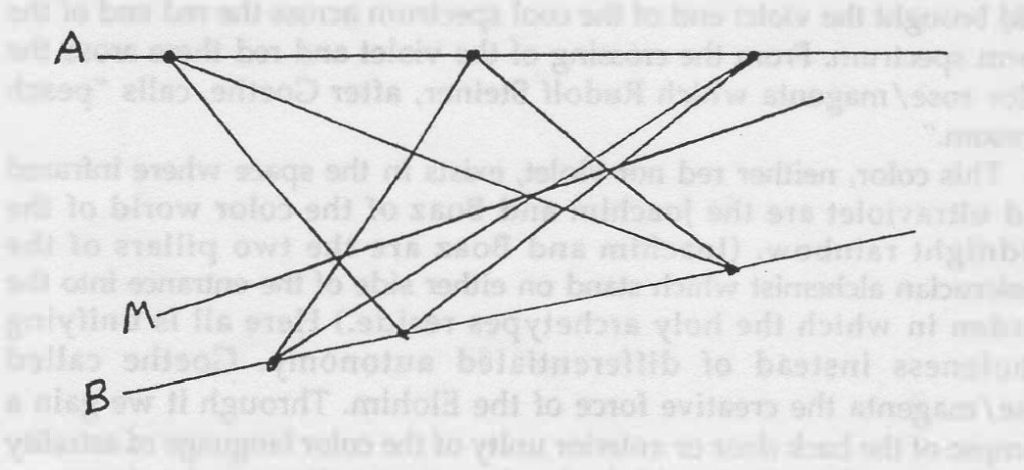
In the glory the green and the rose/magenta are reciprocal polarities. They share in common the dynamic space where it is possible to potentize substances known to anthroposophy as the etheric. In the glory the etheric space is the reciprocal of light darkening (green) and dark lightening (rose/magenta). This reciprocal space has a color of its own (blue) which is an image of the reciprocal dynamic of these two colors. Alchemically we could call this process “the great bluing” The great bluing is a sulfur combustion and its alchemical principle leads to the sulfur/moist pole. Alchemically the “great yellowing” is an example of a phosphorus combustion and its alchemical principle is salt/dry.
Between these processes is the gap of light which has no darkness at its core. It is a cool steady light which is soft and casts no shadows. In place of a core of darkness at its center it is a light in the center of two darknesses.
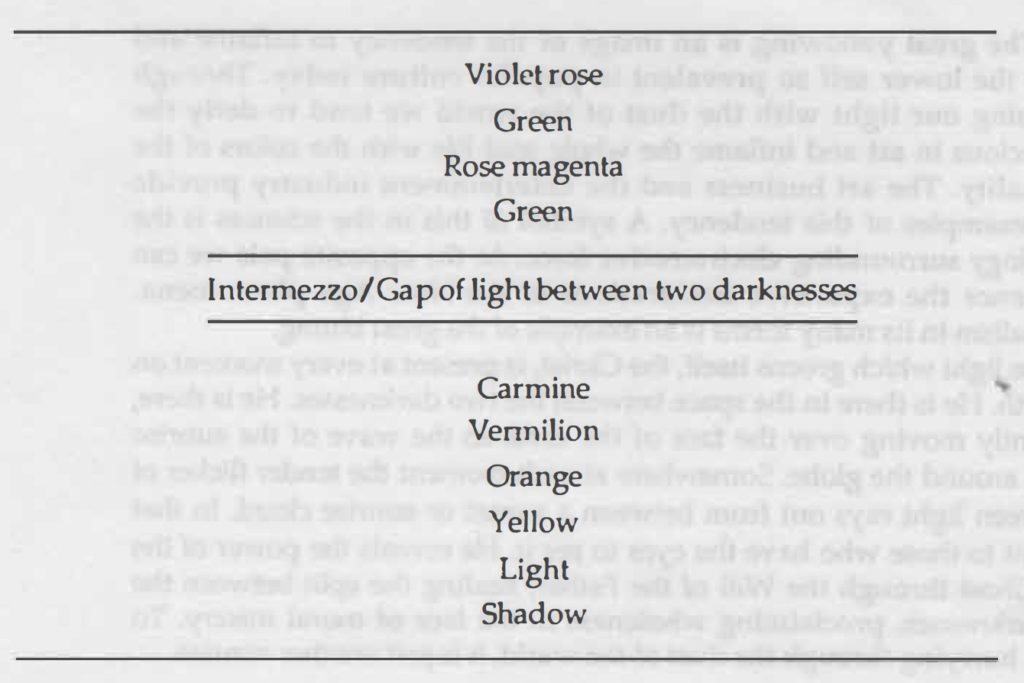
One darkness leads to shadow unconsciousness, and gravity-permeated physicality. This is the differentiating darkness before the light. The other darkness leads to the periphery and expansive levity. This is transcendent, chaotic, creative darkness behind the light. The light itself which lives between two darknesses is not the dry light of incarnation and differentiation. This light is alchemically the great Mercurius, the carbon touchstone, the selfless healer, the Christ. This light softly greening itself as a darkening gesture between two great yawning darknesses is barely perceptible; it is a listening light, full of gratitude, willing to grace the petals of a white rose or the tender folds of a high cirrus cloud. This light, which is casting its dying sacrifice onto earth, is the great balancer between the hubris of the great yellowing and the terror of the great bluing. In the sunrise it comes at the moment when the rose darkness has bloomed and fled to the opposite horizon and the climactic incarnation finale is about to begin. It appears as a fleeting Mercurial tenderness between the gaudy scarves of the pulsing darknesses. The inattentive rarely see it in the morning or evening sky and will even deny its existence but it is there living its balancing life between shreds of brightly colored clouds.
Color and the Soul
Seen in this perspective we could envision the glory phenomenon as an atmospheric rune of the tremendous processes at work in the human soul. The great yellowing is an image of the tendency to inflame and inflate the lower self so prevalent in popular culture today. Through darkening our light with the dust of the world we tend to deify the unconscious in art and inflame the whole soul life with the colors of the personality. The art business and the entertainment industry provide many examples of this tendency. A symbol of this in the sciences is the technology surrounding electromotive force. At the opposite pole we can experience the expansive declarations of the New Age phenomena. Spiritualism in its many forms is an example of the great bluing.
The light which greens itself, the Christ, is present at every moment on the earth. He is there in the space between the two darknesses. He is there, constantly moving over the face of the earth as the wave of the sunrise travels around the globe. Somewhere at each moment the tender flicker of pale green light rays out from between a sunset or sunrise cloud. In that moment to those who have the eyes to see it, He reveals the power of the Holy Ghost through the Will of the Father, healing the split between the two darknesses, proclaiming wholeness in the face of moral misery. To others, hurrying through the dust of the world, it is just another sunrise.
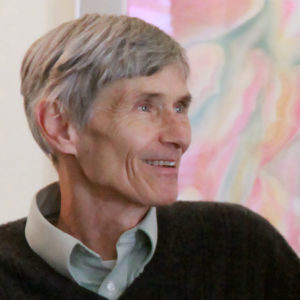
Dennis Klocek
Dennis Klocek, MFA, is co-founder of the Coros Institute, an internationally renowned lecturer, and teacher. He is the author of nine books, including the newly released Colors of the Soul; Esoteric Physiology and also Sacred Agriculture: The Alchemy of Biodynamics. He regularly shares his alchemical, spiritual, and scientific insights at soilsoulandspirit.com.
Similar Writings
Last Supper to Good Friday
Hopefully, the ‘Son of Man’ means more than it did before you came. We are talking about the future human. The one who betrays the future human will not be happy. “It would be better for him that he not be born.” This is about the betrayal of the son of man. Gospel reading: “While…
Eclipse Paths and Tectonic Plates: An Observation of Current Events
I found these two charts worth considering during the annular eclipse today. The one on the right shows the path of totality of the eclipse between Mt. Lassen and Mt. Shasta in northern California. In the chart on the left that path is traced on a seismic map. The black line is the path of…
